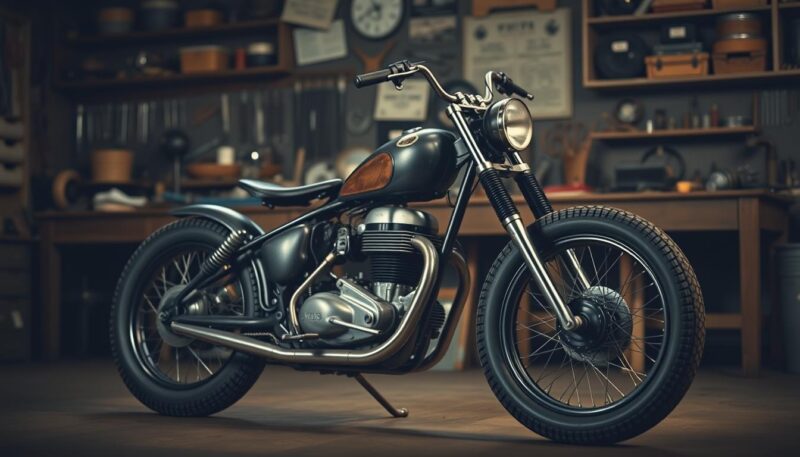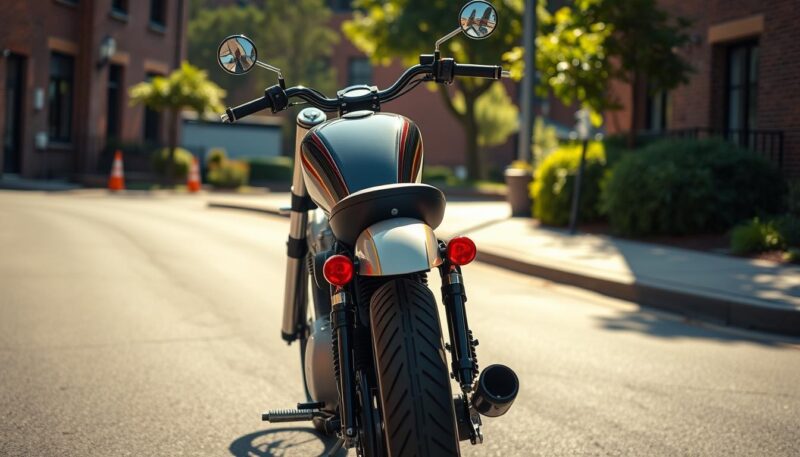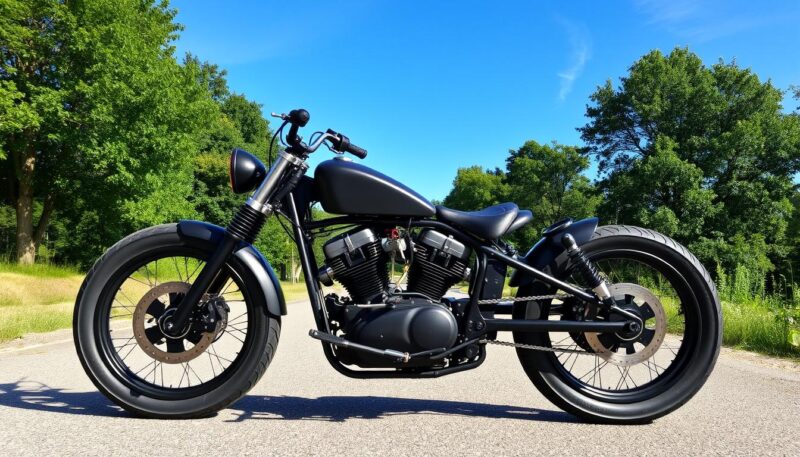When you dive into the world of motorcycles, especially the realm of classic custom bikes, one term that frequently pops up is “Bobber.” So, what is a bobber motorcycle? The Bobber style is not just a category of motorcycles; it’s a movement that harkens back to the early roots of custom bike design. Originating in the late 1920s and gaining traction through the 1940s, the Bobber stands out for its stripped-down, minimalist aesthetic. Its design usually features a shortened rear fender, often omitting the front fender entirely, along with reduced bodywork, allowing for lighter performance. These distinctive stylistic elements have made the Bobber motorcycle a favorite among enthusiasts seeking a unique riding experience.
The transformation of motorcycles into the Bobber style, particularly in the 1930s during a surge of motorcycle racing, has left an indelible mark on motorcycle culture. However, as you explore bobber motorcycle history, you’ll find that this classic custom bike was not merely about looks. It was born out of a desire for speed, simplicity, and individuality. In recent years, even though there has been a slight decline in Bobber’s overall popularity, it remains one of the most sought-after styles amongst custom motorcycle enthusiasts. Whether you’re a seasoned rider or a curious beginner, understanding what makes a Bobber unique provides great insight into the world of motorcycles.
Understanding Bobber Motorcycles
Bobber motorcycles represent a classic style of custom motorcycle that has captivated enthusiasts since the 1930s. Characterized by their simplified aesthetics and emphasis on performance, the term “bobber” refers to the practice of shortening various elements, particularly fenders. What is a bobber motorcycle can often lead to admiration for its rugged charm and unique design. Many riders appreciate the variety within this subgenre, which allows for custom bobber motorcycles to take on many different looks and feels based on personal preferences.
Definition and Description
A bobber is essentially a motorcycle that has been styled to reduce excess weight while maintaining its original frame. The modifications often include shortening the fenders, resulting in a streamlined profile that emphasizes functionality over ornamental features. Custom bobber motorcycles can be created from numerous stock models, without being confined to a single manufacturer. This versatility allows riders to personalize their machines extensively, reflecting their individual tastes and riding styles.
Common Misconceptions
Understanding bobbers comes with a few common misconceptions about bobbers that can mislead newcomers to the motorcycle scene. One prevalent belief is that all bobbers share a uniform aesthetic or must derive from particular brands, which is not true. In fact, a vast array of motorcycles can be transformed into a bobber, creating unique visual identities. Another misunderstanding involves equating bobbers exclusively with choppers. While both types involve customization, bobbers generally utilize a more original frame and retain a focus on simplicity and performance, diverging from choppers’ extensive alterations. Recognizing these distinctions can greatly enhance your appreciation for custom bobber motorcycles.
| Feature | Bobber Motorcycles | Chopper Motorcycles |
|---|---|---|
| Frame Modification | Typically unmodified frames | Highly modified or custom-made frames |
| Design Focus | Simplicity and performance | Style over performance |
| Wheel Size | Similar-sized front and rear wheels | Large diameter front wheels |
| Aesthetic | Rugged, with flat paint or rusty parts | Glossy finishes and chrome parts |
| Customization | Personalized but retains original elements | More extensive and radical modifications |
Origins of Bobber Motorcycles
The origins of bobber motorcycles are rooted in the quest for heightened performance and aesthetic appeal. Riders in the 1920s gravitated toward the ‘cut down’ style, a movement aimed at modifying motorcycles to be more agile and streamlined. This approach laid the groundwork for what would eventually be recognized as bobbers. The essence of this evolution from ‘cut down’ style involved stripping down bikes like the Harley-Davidson “J” series, allowing enthusiasts to shed unnecessary weight while enhancing speed.
Evolution from the ‘Cut Down’ Style
The evolution from the ‘cut down’ style to modern bobbers is intertwined with the cultural landscape of post-World War II America. As soldiers returned home, they desired lighter, sportier bikes reminiscent of those seen during their service. This craving for speed and agility became central to the bobber aesthetic, as riders modified their bikes by removing front and rear fenders, shortening existing structures, and simplifying components.
The Impact of Class C Racing
The impact of Class C racing on bobber motorcycles cannot be overstated. Introduced in the 1930s, this form of racing permitted only cataloged models, driving racers to eliminate superfluous parts in pursuit of victory. This trend influenced the bobber style, emphasizing minimalism in both functionality and appearance. As competitors stripped their bikes down for racing, they inadvertently shaped the cultural image of bobbers as sleek and practical machines.

What is a Bobber Motorcycle? The Key Features
A bobber motorcycle stands out due to its unique design characteristics that emphasize simplicity and performance. The features of a bobber bike revolve around key elements that enhance both aesthetics and functionality. Riders often appreciate the distinct visual appeal and the practical aspects that come with this design philosophy.
Design Characteristics
The design characteristics of bobbers contribute significantly to their charm. These motorcycles typically showcase:
- Low profiles with a triangular-shaped seat
- Peanut-shaped fuel tanks
- High handlebars that provide an upright riding position
- Minimal or reduced fenders to decrease weight and enhance speed
Models like the Harley-Davidson Street Bob 114 and the Indian Chief Bobber exemplify the features of a bobber bike, showcasing how weight reduction aligns with efficient performance. The interaction of these elements forms a cohesive look that appeals to many motorcycle enthusiasts.
Customization Possibilities
For those interested in customizing your bobber motorcycle, the options are nearly limitless. Customizing can be tailored to fit personal preferences or specific requirements. Some popular customization options include:
- Variety of seat styles, ranging from solo to dual
- Different handlebar types for enhanced comfort and control
- Custom exhaust systems that enhance sound and performance
- Distinctive paint jobs to reflect individual style
This flexibility is a key attraction for many who choose to own a bobber motorcycle. Whether you select a classic model like the Triumph Bonneville Bobber or opt for a unique build, customizing your bobber motorcycle allows for personal expression and a connection to the craft of motorcycle building.

| Model | Engine Size | Horsepower | Torque | Weight |
|---|---|---|---|---|
| Harley-Davidson Street Bob 114 | 1,868 cc | 94 hp | 161 Nm | Over 600 lbs |
| Triumph Bonneville Bobber | 1,200 cc | 76.9 hp | 106 Nm | Over 500 lbs |
| CCM Bobber | 600 cc | 55 hp | 55 Nm | Just over 300 lbs |
| Indian Chief Bobber | 1,811 cc | N/A | 146 Nm | Over 600 lbs |
| Indian Scout Bobber | 1,250 cc | 105 hp | 111 Nm | Over 500 lbs |
Conclusion
Understanding what a bobber motorcycle is requires an appreciation of its fascinating history and distinctive features that make it a standout in the motorcycle world. Originating in the 1930s, the bobber motorcycle history reveals a journey fueled by the desire for enhanced performance through minimalism. This pivot towards simplicity has led to the creation of bikes that are both aesthetically striking and highly customizable.
The features of a bobber bike typically include shortened fenders, stripped-down bodywork, and an overall low-slung profile, which symbolizes the rebellious spirit of its riders. With donor bikes like Harley-Davidson Sportsters and Triumph Bonnevilles, enthusiasts can easily embark on a journey to create a unique biking experience tailored to their preferences. Whether you are drawn by the allure of customization or the performance-driven design, the essence of the bobber persists, making it a pivotal element in the rich tapestry of American motorcycle culture.
Ultimately, the appeal of bobber motorcycles lies in their embodiment of individuality and the thrill of the ride. As you explore options for your own custom bobber, consider how the modified elements reflect your personality and riding style. The legacy of bobbers continues to thrive, inviting a new generation of motorcycle enthusiasts to join the ranks of those who cherish this iconic custom motorcycle.






